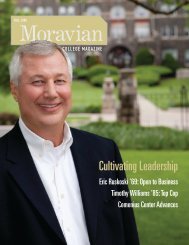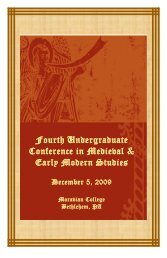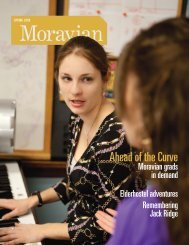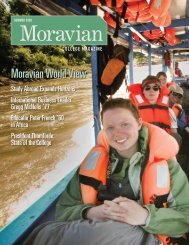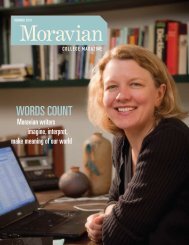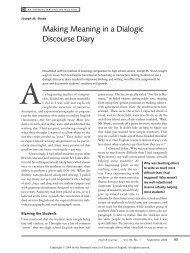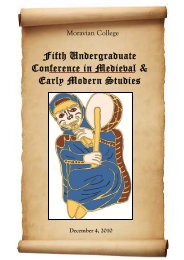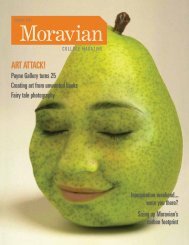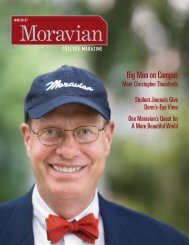MORAVIAN VISION - Moravian College
MORAVIAN VISION - Moravian College
MORAVIAN VISION - Moravian College
Create successful ePaper yourself
Turn your PDF publications into a flip-book with our unique Google optimized e-Paper software.
Breaking Barriers<br />
As told by Priscilla Payne Hurd<br />
I’ve always rooted for the underdog, and when I first became involved<br />
with <strong>Moravian</strong> <strong>College</strong>, it was an underdog.<br />
I was born and brought up in Chicago, and moved here only<br />
because I married a man who worked for the steel company. Herman<br />
Collier [<strong>Moravian</strong> <strong>College</strong> president 1969-1986] asked if I’d be interested<br />
in knowing about <strong>Moravian</strong>. To be polite I said, well, yes. He<br />
sent me some information. It impressed me as a typical college and I<br />
didn’t think much more about it.<br />
Sometime later, I sat next to Herman at a dinner party, and we<br />
talked—he could be very persuasive. He asked me to join an auxiliary<br />
for the <strong>College</strong>, and I agreed. Before long, I was captivated. I discovered<br />
that <strong>Moravian</strong> is really a hidden gem. The <strong>Moravian</strong> people<br />
tend to hide their brightness under a bushel. They are taught to be<br />
humble. Well, I thought, this college doesn’t know what it has!<br />
<strong>Moravian</strong> has a beautiful campus, but its potential is not fully<br />
developed. When I became board chair in 1999,<br />
I promised the new building [the Priscilla Payne<br />
Hurd Academic Complex] would go up because<br />
the faculty had waited thirty years for it. Fulfilling<br />
my promise was important to me. I love<br />
everyone who works here, including those who work on the grounds<br />
and those who serve meals. It’s important to appreciate everybody—<br />
not just those who stand out or who are on top. Everyone here is very<br />
nice to me—very, very kind—and I’ve tried to reciprocate.<br />
I’d like to see us do so much more than we’re doing here at <strong>Moravian</strong>,<br />
but we need more money to do it. I get annoyed with those who<br />
say we should do this or that, but who don’t contribute. Many people<br />
don’t understand we need a broad base. Little things add up. You<br />
might raise $50, then $100, and before you know it, you’re very close<br />
to your goal. But the last part is the hardest in the world to get. That’s<br />
true about any amount—whether $5 or $5 million.<br />
I believe some very successful people have forgotten their roots.<br />
They don’t seem to appreciate the reasons they’re living the way<br />
they are. It can be very difficult to reach them, and you can become<br />
discouraged. But you can’t let them know. Someone said to me, “every<br />
time I see you, you’re asking me for money.” And I said yes, because<br />
you’ve never given me any. If you give me some, I’ll stop asking.<br />
I suppose I assimilated some of my attitudes in childhood. When I<br />
was ten, my mother took me to visit Hull House in Chicago. It was<br />
in a very poor section of the city, where many immigrants lived in<br />
tenements. I met Jane Addams, the co-founder of Hull House, in 1934,<br />
the year before she died. She was old-fashioned, but very strong and<br />
purposeful. Not only was she among the first to advocate for women’s<br />
rights, but she also established one of the first settlement houses in<br />
the United States, providing community-based social, educational, and<br />
artistic programs. She was ahead of her time, and I was in awe of her.<br />
As the first woman chair of the <strong>Moravian</strong> Board of Trustees, I<br />
knew I had to convey a similar strength. I had to signal I was the<br />
boss. I established how we would work and everyone understood<br />
there would be no nonsense. If you don’t have clear ground rules, you<br />
can’t be very effective.<br />
><br />
I suspect my background in radio helped me, too. I had studied<br />
radio technique in school. When I came to Bethlehem I joined the Junior<br />
League, and they decided they’d like to do a radio show about the<br />
United Nations (“UN Calling You”), which was just a fledgling organization<br />
at the time. We got students to do the acting, somebody wrote<br />
the script, and I worked behind the scenes directing the show. Directing<br />
a radio play is somewhat like directing a board, I believe. You must<br />
be able to move things along. Both have the same “to-and-fro-ing.”<br />
I’m very businesslike in board meetings, but I believe it’s important<br />
to maintain a sense of humor as well. Life is so serious. Scary, depressing.<br />
If you don’t have a sense of humor, forget it. If you look hard enough,<br />
you can see something funny in almost anything. It can be the saving<br />
grace. Many people take themselves so seriously. I say, fine, take the job<br />
seriously. But don’t take yourself so seriously. We’re all human. �<br />
Priscilla Payne Hurd has served as a member of the <strong>Moravian</strong> <strong>College</strong> Board of Trustees<br />
since 1974. She became the first woman board chair in the <strong>College</strong>’s history in 1999,<br />
serving until 2007. Mrs. Hurd is a graduate of Finch <strong>College</strong>, the University of Chicago, and<br />
the New York School of Radio Technique.<br />
Prelude features stories from the <strong>Moravian</strong> <strong>College</strong> community, told in the storyteller’s<br />
own words. Send ideas or submissions to VBingham@moravian.edu.<br />
LEFT: Mrs. Hurd’s generous support can be seen and experienced throughout the <strong>Moravian</strong> campus. The Hurd Center for Music and Art encompasses Foy Concert Hall,<br />
Payne Art Gallery, South Hall, the 1867 Chapel, West Hall, and the Single Brethren’s House. The Priscilla Payne Hurd Academic Complex (completed in 2002), includes “smart<br />
classrooms" equipped with computer stations and multimedia equipment. Mrs. Hurd also supports the prestigious Comenius Scholarships, as well as the SOAR program.<br />
ABOVE: At the Payne Art Gallery, students view Walter Elmer Schofield's "Sunlit Coast" (ca. 1930), a Pennsylvania impressionist oil on canvas painting donated by Mrs. Hurd.<br />
FALL 2008 <strong>MORAVIAN</strong> COLLEGE MAGAZINE 3



